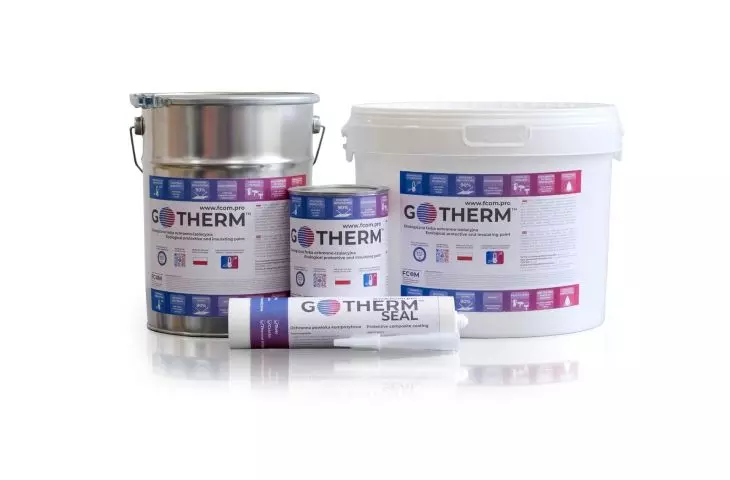GoTherm® thermal insulation paints.
From the series "Paints - innovations 2021"
There are many ways to insulate buildings thermally. One of them is specialized paint, which is gaining more and more interest from year to year among specialists. All thanks to its properties, wide application possibilities and ease of application. We invite you to learn more about Polish GoTherm® thermal insulation paint.
Properties of thermal insulation paint
Thermal insulating paints have a number of properties that make them great for construction work.
First of all, the insulating layers make it impossible for water to condense on surfaces painted with them. As a result, a wall painted with it retains its structure longer and is protected from heat loss.
Secondly, it turns out that heat-insulating paints stop mold and fungus from flourishing on walls, and also eliminate some harmful bacteria that appear on various surfaces. This is because the GoTherm® coating prevents thermal bridges, places where moisture often appears, which is necessary for mold and fungus to flourish.
Third, the insulating paint will reflect as much as 90% of the sun's rays, lowering the temperature in halls and other buildings painted with it.
Fourth, it insulates hot surfaces, thereby reducing the risk of burns.
It is also worth noting that the properties of the paint remain unchanged over time, which means that the paint has constant insulating parameters.
© FCOM
What else is worth knowing about thermal insulation paint?
A one-millimeter coating dries about 24 hours at 20 degrees and considerably less at 40°C. It is also worth remembering that a single layer of paint should not be more than just 1 mm. What's more, based on the research done and customer experience, it can be considered that 1 mm of GoTherm® paint is equivalent to about 2-2.5 cm of polystyrene foam.
The paint is white in color, but can be tinted to any color. After it dries, you can also apply another coat of any water-based paint.
GoTherm® paint is also environmentally friendly - it has no chemical solvents in its composition, is water-based, and has a very low content of VOCs, i.e. Volatile Organic Compounds dangerous to health (0.6 g/l).
© FCOM
Thermal insulation paint - application methods
Insulating coatings are easy to apply. For example, GoTherm® paint can be applied with a roller or brush. You can also use a spatula or an aggregate. In the former case, the paint has a thinner consistency than in the latter. Therefore, it is important to know which application method you will use when purchasing.
What surfaces are suitable for thermal insulation paint?
The paint can be applied to virtually any surface. It will work great on concrete and plaster to insulate the walls of buildings. You can confidently paint metal parts with it, so they will not heat up much. Such a property will be especially useful in factories, where you can isolate hot surfaces and increase the safety of workers.
Paint insulation can also be applied to wood and plastics (except polyethylene).
© FCOM
When to use thermal insulation paint?
Thermal insulation paint can be used as additional insulation for a building. This will allow the use of an insulating layer of polystyrene foam of less thickness, which will affect the cost of purchase and installation, and often the appearance of the building.
In addition, there are many buildings in which polystyrene foam can not be used. We are talking, for example, about buildings listed in the register of historical monuments. Many historic preservationists do not agree to insulating with Styrofoam panels. However, there is a way around this. The ideal solution is thermal insulation paint. It does not interfere with the appearance of the building, but adds a solid insulation layer.
Also, when we want to do insulation inside. It may happen that we want to insulate a room from the inside. For example, when we do not want to destroy the current facade. Of course, laying Styrofoam from the inside is possible, but it is incompatible with the art of construction and will simply make the insulated room smaller. In such a situation, it is much better to use thermal insulation paint, which has similar properties, and at the same time does not affect the volume of the room.
© FCOM
How does heat-insulating paint work?
Thermal insulating paint is a composite material on a matrix of acrylic resin, reinforced with ceramic microspheres, in which there is a vacuum-like vacuum. And this increases the resistance to heat. The principle of heat-insulating paint is similar to that of Styrofoam panels, which consist of many foamed polystyrene granules and form a cellular structure. The same is true of thermal insulation coatings, where the role of granules is precisely played by glass microspheres. Thus, the same effect, is achieved on a micro scale. It is worth noting that a small layer of paint is enough to notice its effect. Thus, painting the hall with a layer of only 0.5 mm, will begin to reflect sunlight from it, effectively reducing the heating of the interior. Slightly thicker layers need to be applied to counteract mold and mildew on the wall (1 mm of paint). In contrast, to insulate hot surfaces, such as pipes in factories, a layer of 1.3 mm of paint is sufficient.
Thermal insulation paint is certainly worth considering when insulating a building. We understand that this is a relatively new product, so we will be happy to help you choose the right amount and type of paint. We encourage you to contact us.
For more information, visit the company's FCOM page on the A&B portal.


































